By Shereen Bar-or Becerra, MPS, LCAT, ATR-BC
Creating superheroes and villains from our personality traits and challenges is one of my favorite directives as an Art Therapist. It creates a playful opportunity for clients to assess perceived strengths and areas of growth from a safe distance through metaphor and projective assessment. If I had to summarize my insecurities growing up, I’d be a villain known as “The Over-compensator.”
I held a deep inadequacy from feeling like an outsider, always different and unseen. I struggled to form my own identity as an Iranian Jewish first-generation American born in Saddle River, New Jersey. My Persian Jewish nose and wild, black hair stuck out in my small town’s school cafeteria at lunchtime. The smell of khoresht offered contrast in a sea of sandwiches on white bread. I tried to compensate for my differences and blend in as much as possible. (Hello chemical hair straightening and Juicy Velour jumpsuits!) I was an imposter in the American world and in the Persian Jewish community.
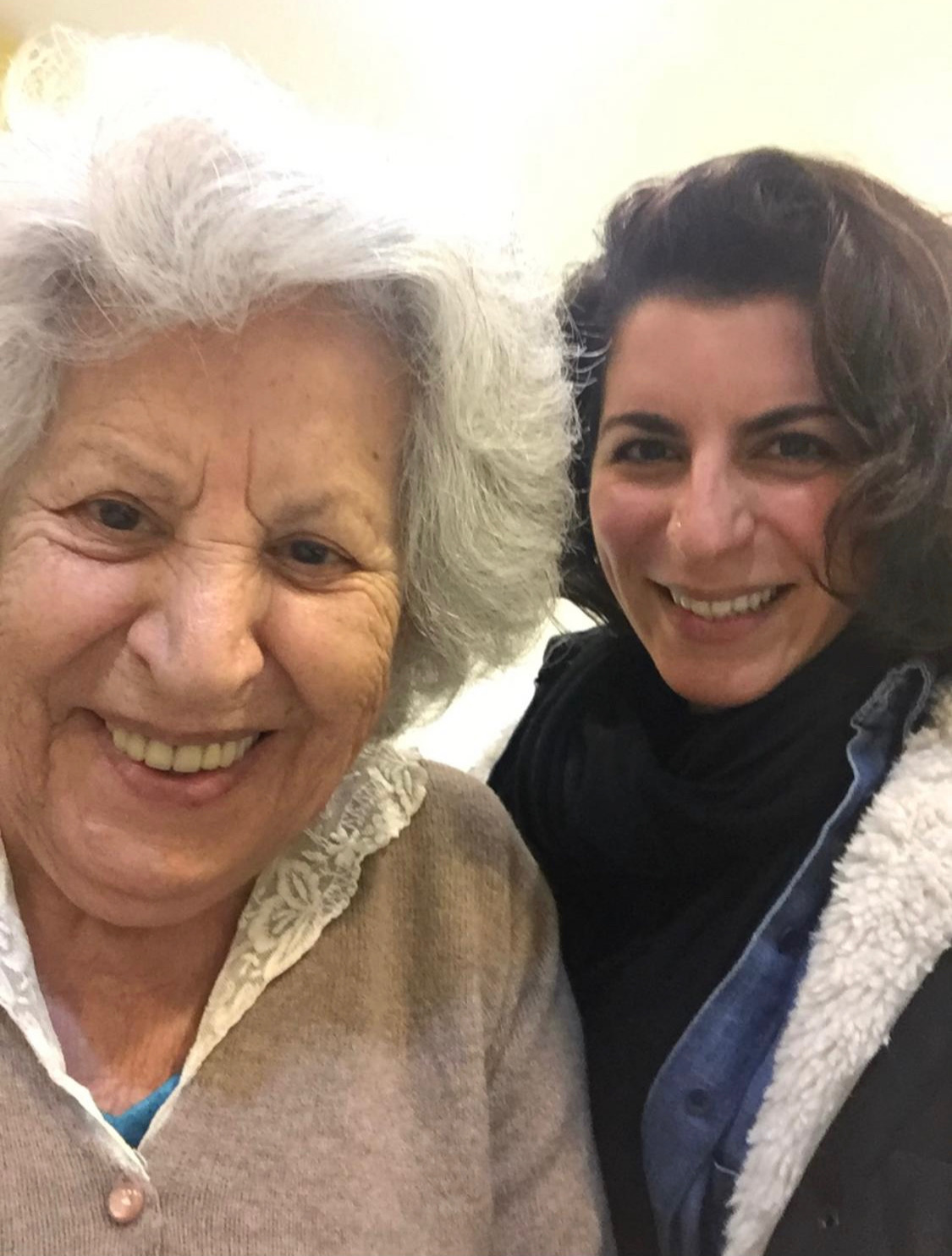
Shereen with her paternal grandmother, Eshrat Baradarian, who is fondly called “Eish” and is arguably the best cook in the entire family.
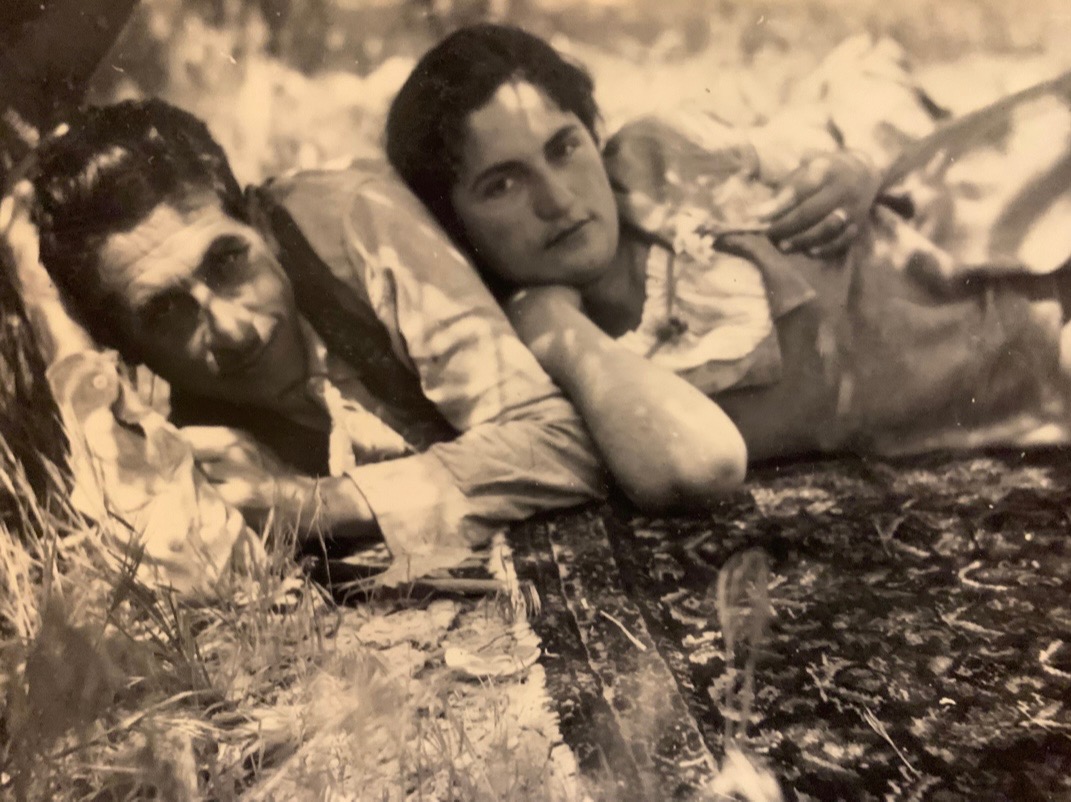
Shereen’s maternal grandparents, Ester and Itzchak Mottahedeh, in the city of Abadan in Iran sometime in the early 1950s.
My father left Iran prior to the Islamic Revolution of 1979. He was constantly harassed for being Jewish and felt suffocated by the lack of opportunity for him. After emigrating from Iran to Israel and eventually to America, he worked his way from peddling items on the streets of Newark to owning a chain of women’s clothing stores called “Zan,” meaning “woman” in Farsi. The word Zan has become part of the slogan of the Iranian revolution: Zan, Zendegi (Life), Azadi (Freedom). My mother’s family left Iran for Israel when she was a toddler. While my mother wanted to remain in Israel, when she came to the United States, she pursued an education at Queens College and worked a wide range of jobs from designing clothing to real estate to echo sonography.
I never found my footing at school and I felt suffocated by the standards and expectations of my family. The burden of navigating adolescence as an American with an Iranian and Jewish background was difficult for me. I later learned that the challenges of merging different cultures are typical for Third Culture kids. Third Culture refers to the mixed identity an individual assumes that is influenced both by their parents’ culture and the culture in which they are raised.
Simultaneously, I was stunted by cultural messaging and conditioning from both sides to be a “good girl” in different ways. In America, it was the age of low-rise jeans and Paris Hilton’s overtly sexualized behavior. But at home, I was taught to mind my manners to avoid shameful behavior at all costs. Displaying emotion was strongly discouraged as it would risk appearing unbecoming or inadequate. As a young girl, I was conditioned to prioritize other people’s wants over my own needs and boundaries. Trying to keep myself from making waves turned into creating emotional tsunamis. I was paralyzed by my conflicted feelings and didn’t know how to build a healthy balance. I began to hate every aspect of myself. When I became triggered, The Over-compensator showed up to protect me by being unruly, ungovernable, and outspoken.
Working with a Spunky Psychologist, I Was Introduced to Art Therapy
This culture clash made it all the more necessary for me to learn how to integrate these experiences and create a space where I could be myself. Navigating two marginalized cultures within the context of the dominant culture can be emotionally distressing—sometimes even traumatic. I decided that healing had to become a priority. It wasn’t until I began to unlearn all the things I was “supposed” to be that I could begin to explore my authentic self. I set out to learn more about mental health support and quickly realized I needed something more than the typical therapeutic experience—something beyond a silent nodder with a trigger finger for their prescription pad. It wasn’t until I started working with a spunky psychologist who got her masters in creative arts therapy that I was introduced to art therapy. She enthusiastically encouraged me to look into art therapy, even possibly as a future career. She was absolutely right.
I focused on art and psychology related courses in high school and curated my undergraduate experience to major in human development and minor in visual arts and global affairs. I was drawn to the world of creative arts psychotherapy for its emphasis on creativity and active engagement in treatment. I saw how effective it was to show up authentically and to encourage a client’s own creativity, especially when processing emotions and problem-solving. Art Therapy was the antidote The Over-compensator and many others like me needed. I pursued a career in Art Therapy because I experienced first-hand how dynamic and restorative healing can be when creativity is encouraged.
Art Therapy is based on psychological theory and built upon a human truth: art is a universal language. Art therapy has been shown to be effective in the treatment of anxiety, depression, and trauma because of its unique and intentional approach to healing. Cultural and societal norms create barriers in addressing and acknowledging our emotions surrounding trauma. These barriers can make the healing process difficult to access for many out of shame or guilt. In addition, trauma impacts the brain and body and can impact the ability to express and communicate emotions and experiences as well. Trauma also impacts cognitive and executive functioning, emotional regulation, and memory and learning capacity. Creativity combats these issues by helping to regulate the nervous system and stress response, and builds self esteem and our capacity for resilience.
Art Therapy offers alternative methods to traditional healing because it incorporates clinical technique with the creative process. It gives voice to individuals’ experiences and makes emotions visible. We relearn how to safely be in our bodies and hold space for our emotions through the physical sensations of art making and exploration. Exploring complex emotions through the creative process not only reduces physiological stress, but creates new neural pathways to heal by offering new perspectives to process experiences.
As an Art Therapist
As a credentialed art therapist, I realize the importance of self-care in order to effectively show up for my clients. For the first time, I felt empowered to truly see and examine myself and sublimate my rage into my strength. Equipped with improved coping mechanisms and more self awareness than my adolescence, I noticed, greeted, and learned about my anger. I unlearned the conditioning to withhold my desires, emotions, and limits. I began expressing my needs directly. I created boundaries that supported my growth. The more intentional I became, the more powerful I felt—and the better I was able to integrate aspects of identity and cultures.
As the first person in my family to marry a non Jew, I began to consciously choose how to honor and incorporate my heritage into my everyday life. I choose to celebrate both Rosh Hashanah and Nowruz, the Jewish and Persian New Years. (In fact, for our co-ed bridal shower, we chose Nowruz as the theme, which means “new day”!) I mastered the balance of cardamom and cayenne in my gondi following my Grandmother Eish’s recipe. I have yet to get there with tahdig but will continue to perfect it until the pillowy saffron rice underneath the golden brown crust matches hers. I continue to learn Farsi. I draw strength from my upbringing and the stories I’d hear about badass Iranian women who defied the odds to fight back against dictatorial expectations. I am inspired by their courage in defying standards and their resilience to create something better for themselves.
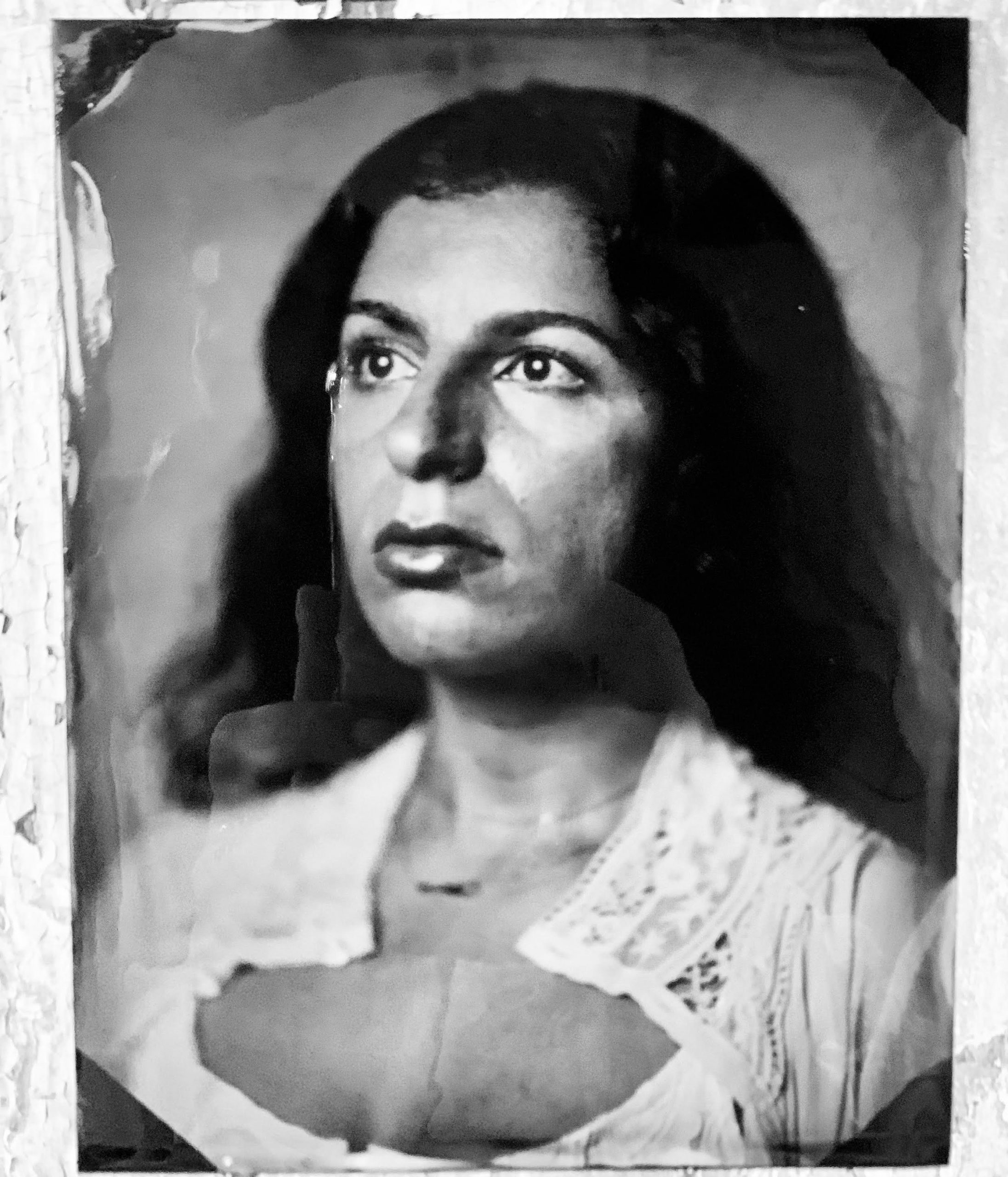
A recent tin type portrait taken of Shereen, a birthday gift from her husband, Shane Becerra.
In Iran, Their Rage Has Turned Into Revolution
Especially now, to witness the girls and young women of Iran fighting back against the regime is unfathomable. After decades of brutal fundamentalism, they are centering the narrative on their own needs, hopes, and desires. I understand the impact of transgenerational trauma and the strength it takes to break cycles of internalized beliefs and harmful systems of abuse. I call upon my intergenerational wisdom to challenge what I want to change.
Unprocessed trauma leads to rage. What we do with that raw emotion is what matters. For me, I had to acknowledge The Over-compensator in order to turn my rage into my superpower. I learned to see myself differently and help others to do the same through art therapy.
In Iran, their rage has evolved into a revolution. For my fellow diaspora Iranians, I recognize my role within my career and this movement is to hold space for the decades of trauma to help push this movement forward. Fight is ingrained in my blood—as is healing. I am in awe of the ferocity of Iranian women. I connect with their fiery will and testament to evolve and change for the better. I honor how heartwarming it is to witness their bravery in this revolution and acknowledge how demoralizing it is to know the brutality they are up against. My experience is a shared birthright with my ancestors and one I hope to pass on to my own children: the spirit and tenacity to push boundaries and create space in places we were never welcome. They say you can’t burn women made of fire.
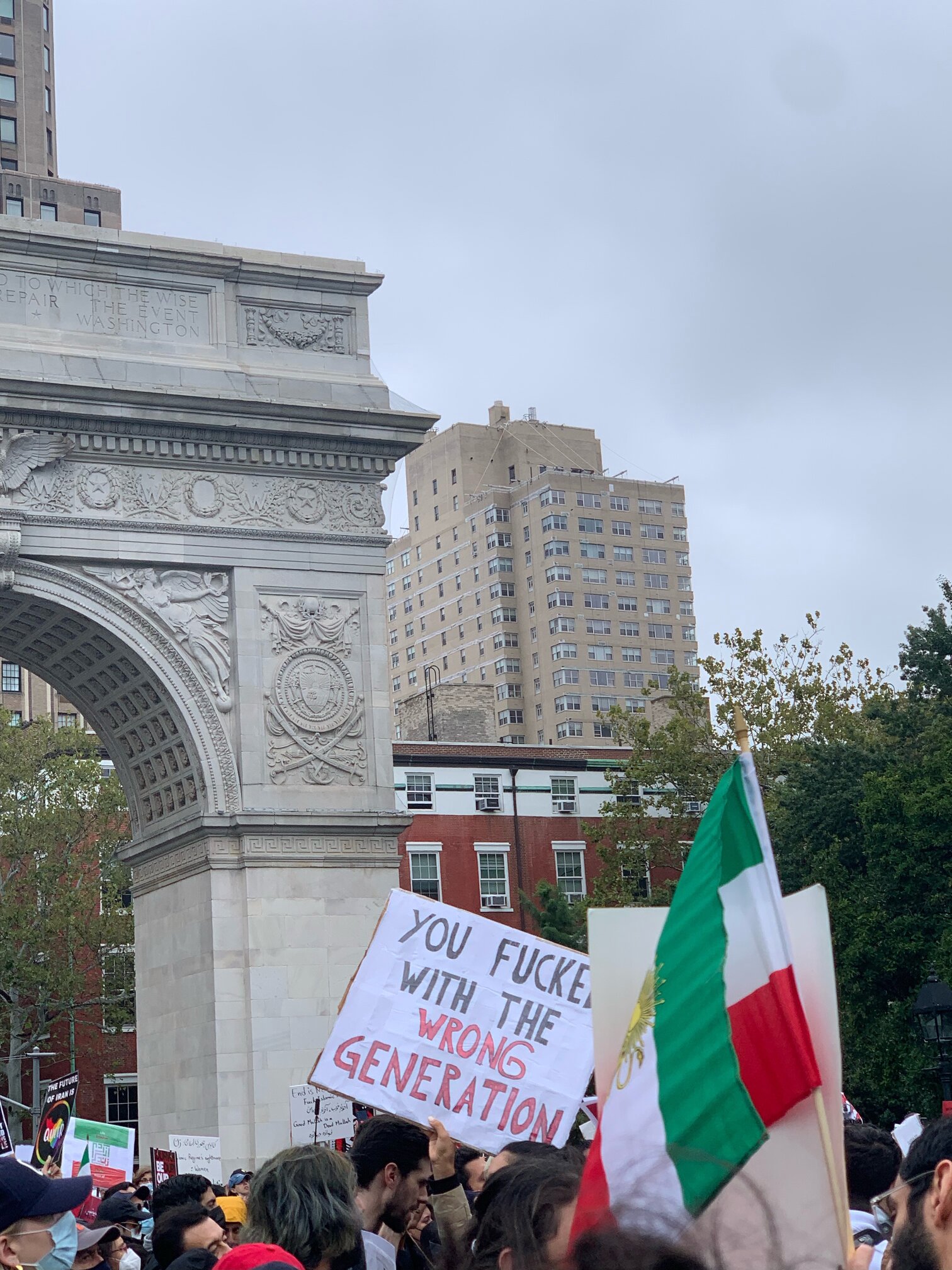
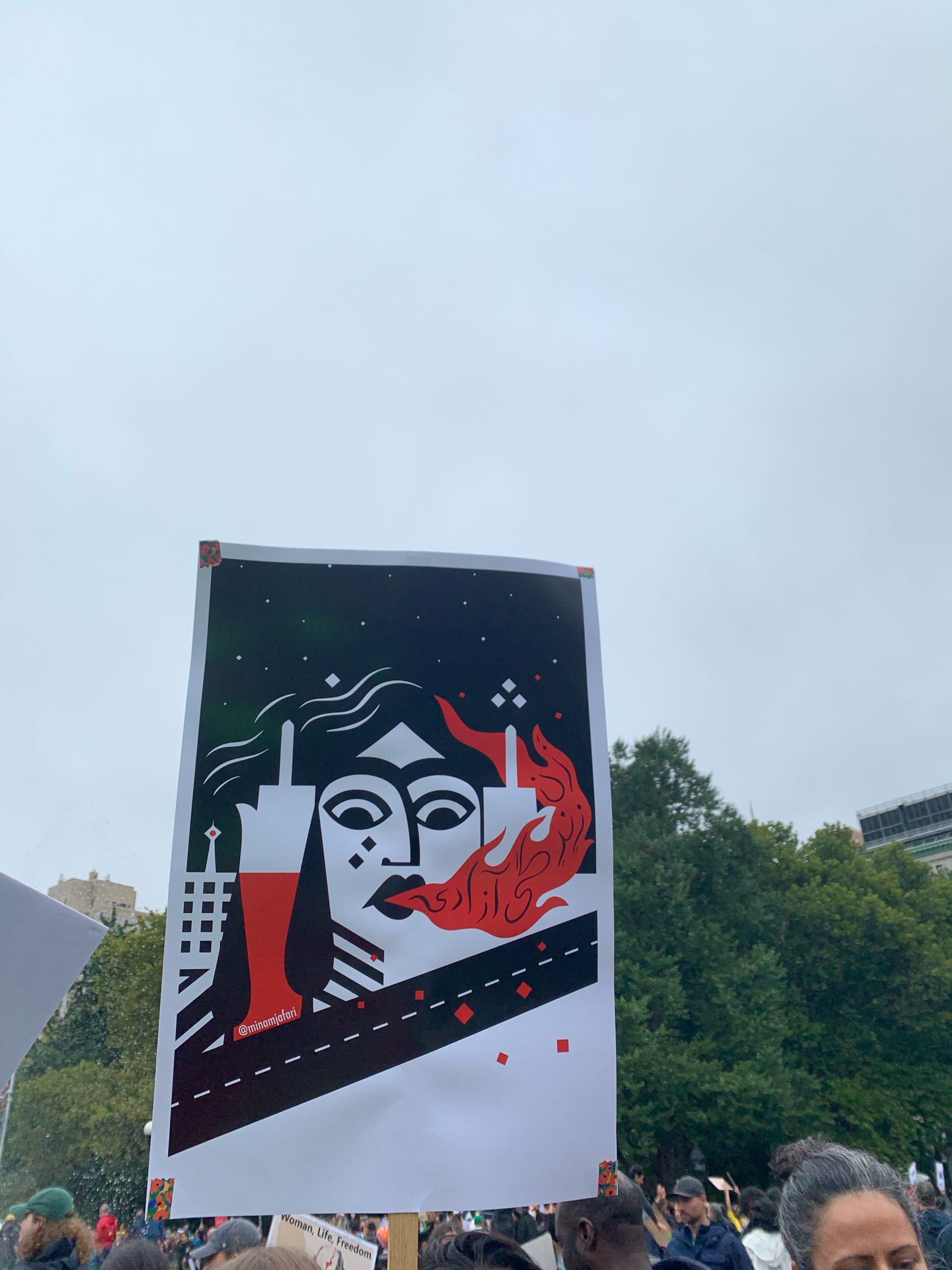

Photos taken by Shereen from the October 2, 2022 protest held in Washington Square Park, NYC
against the murder of Mahsa Amini and for the liberation of Iranian people.
Join Us at an Iranian Diaspora Support Group in Brooklyn (Date TBD)
Shereen is hosting a self-care workshop for Iranians in NYC through her practice, Art Therapy Collective (ATC), a creative wellness space based in New York City. It is free for everyone to participate and will be held in Brooklyn. Stay tuned for more details, including date and location, through the ATC website or on Instagram @atcbklyn.
About Shereen Bar-or Becerra
Shereen Bar-or Becerra, MPS, LCAT, ATR-BC, founded the Art Therapy Collective in New York and serves as Social Action Chair for the New York Art Therapy Association.
In her personal and professional life, Shereen builds on the tenets of creativity, mindfulness, and trauma-informed care into daily practices of self-care and collective wellness. Shereen’s work experience includes group practices, community and family programming, educational settings, and foster care. Coming from these experiences and as a first generation American, the bulk of Shereen’s work is a sustained effort to dismantle systems of oppression ranging from harmful internalized beliefs and maladaptive behaviors to external systems and institutions. Shereen lives in Brooklyn and loves to be creative in her spare time, spend time with her partner and their 2 cats, and immerse herself in nature whenever possible.
Learn more about Shereen through the ATC website or on Instagram @atcbklyn or @shereendabean
